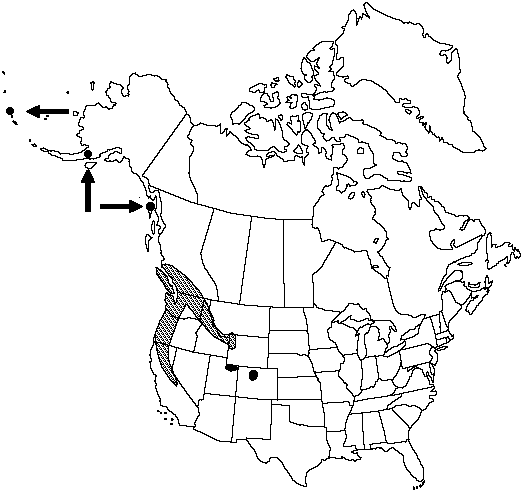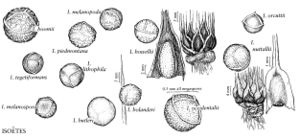Difference between revisions of "Isoëtes occidentalis"
Bull. Torrey Bot. Club 27: 358. 1900.
FNA>Volume Importer |
imported>Volume Importer |
||
| (7 intermediate revisions by 2 users not shown) | |||
| Line 12: | Line 12: | ||
|name=Isoëtes flettii | |name=Isoëtes flettii | ||
|authority=(A. A. Eaton) N. E. Pfeiffer | |authority=(A. A. Eaton) N. E. Pfeiffer | ||
| − | }}{{Treatment/ID/Synonym | + | |rank=species |
| + | }} {{Treatment/ID/Synonym | ||
|name=Isoëtes lacustris var. paupercula | |name=Isoëtes lacustris var. paupercula | ||
|authority=Engelmann | |authority=Engelmann | ||
| − | }}{{Treatment/ID/Synonym | + | |rank=variety |
| + | }} {{Treatment/ID/Synonym | ||
|name=Isoëtes paupercula | |name=Isoëtes paupercula | ||
|authority=(Engelmann) A. A. Eaton | |authority=(Engelmann) A. A. Eaton | ||
| − | }}{{Treatment/ID/Synonym | + | |rank=species |
| + | }} {{Treatment/ID/Synonym | ||
|name=Isoëtes piperi | |name=Isoëtes piperi | ||
|authority=A. A. Eaton | |authority=A. A. Eaton | ||
| + | |rank=species | ||
}} | }} | ||
|hierarchy=Isoëtaceae;Isoëtes;Isoëtes occidentalis | |hierarchy=Isoëtaceae;Isoëtes;Isoëtes occidentalis | ||
| Line 29: | Line 33: | ||
}}<!-- | }}<!-- | ||
| − | --><span class="statement" id="st- | + | --><span class="statement" id="st-undefined" data-properties=""><b>Plants </b>aquatic. <b>Rootstock</b> nearly globose, 2-lobed. <b>Leaves</b> evergreen, dark green, pale toward base, spirally arranged, to 20 cm, rigid, gradually tapering to tip. <b>Velum</b> covering less than 1/2 sporangium. <b>Sporangium</b> wall unpigmented. <b>Megaspores</b> 500–700 μm diam., cristate, tuberculate, rugulate, or echinate with ridges, tubercles, or spines; girdle smooth. <b>Microspores</b> brown in mass, 35–45 μm, papillose to spinulose. <b>2n</b> = 66.</span><!-- |
-->{{Treatment/Body | -->{{Treatment/Body | ||
| + | |phenology=Spores mature in late summer. | ||
|habitat=Lakes | |habitat=Lakes | ||
|distribution=B.C.;Alaska;Calif.;Colo.;Idaho;Mont.;Oreg.;Utah;Wash.;Wyo. | |distribution=B.C.;Alaska;Calif.;Colo.;Idaho;Mont.;Oreg.;Utah;Wash.;Wyo. | ||
| − | |discussion=<p>Megaspores of Isoëtes occidentalis are variable in wall pattern. Populations exist with rugulate or tuberculate megaspores and other population with cristate to echinate megaspores. Plants with thin-walled megaspores that crack easily have been called I. paupercula. Populations in which megaspores have short ridges and tubercles in a band along the equator have been called I. flettii. Populations with broad-based tubercles on the megaspores have been called I. piperi. The variation in megaspore pattern may indicate multiple allopolyploid origins for I. occidentalis.</p><!-- | + | |discussion=<p>Megaspores of <i>Isoëtes occidentalis</i> are variable in wall pattern. Populations exist with rugulate or tuberculate megaspores and other population with cristate to echinate megaspores. Plants with thin-walled megaspores that crack easily have been called I. paupercula. Populations in which megaspores have short ridges and tubercles in a band along the equator have been called I. flettii. Populations with broad-based tubercles on the megaspores have been called I. piperi. The variation in megaspore pattern may indicate multiple allopolyploid origins for <i>I. occidentalis</i>.</p><!-- |
| − | --><p>The general aspect of Isoëtes occidentalis and its tough, dark green leaves suggested to early workers an affinity with I. lacustris.</p><!-- | + | --><p>The general aspect of <i>Isoëtes occidentalis</i> and its tough, dark green leaves suggested to early workers an affinity with <i>I. lacustris</i>.</p><!-- |
| − | --><p>Isoëtes occidentalis hybridizes with I. bolanderi, I. echinospora, and I. maritima [ = I. x truncata (A. A. Eaton) Clute].</p> | + | --><p><i>Isoëtes occidentalis</i> hybridizes with <i>I. bolanderi</i>, <i>I. echinospora</i>, and <i>I. maritima</i> [ = I. x truncata (A. A. Eaton) Clute].</p> |
|tables= | |tables= | ||
|references= | |references= | ||
| Line 45: | Line 50: | ||
-->{{#Taxon: | -->{{#Taxon: | ||
name=Isoëtes occidentalis | name=Isoëtes occidentalis | ||
| − | |||
|authority=L. F. Henderson | |authority=L. F. Henderson | ||
|rank=species | |rank=species | ||
| Line 52: | Line 56: | ||
|basionyms= | |basionyms= | ||
|family=Isoëtaceae | |family=Isoëtaceae | ||
| + | |phenology=Spores mature in late summer. | ||
|habitat=Lakes | |habitat=Lakes | ||
|distribution=B.C.;Alaska;Calif.;Colo.;Idaho;Mont.;Oreg.;Utah;Wash.;Wyo. | |distribution=B.C.;Alaska;Calif.;Colo.;Idaho;Mont.;Oreg.;Utah;Wash.;Wyo. | ||
| Line 58: | Line 63: | ||
|publication year=1900 | |publication year=1900 | ||
|special status= | |special status= | ||
| − | |source xml=https:// | + | |source xml=https://bitbucket.org/aafc-mbb/fna-data-curation/src/2e0870ddd59836b60bcf96646a41e87ea5a5943a/coarse_grained_fna_xml/V2/V2_479.xml |
|genus=Isoëtes | |genus=Isoëtes | ||
|species=Isoëtes occidentalis | |species=Isoëtes occidentalis | ||
| − | |||
| − | |||
| − | |||
| − | |||
| − | |||
| − | |||
| − | |||
| − | |||
| − | |||
| − | |||
| − | |||
| − | |||
| − | |||
| − | |||
| − | |||
| − | |||
| − | |||
| − | |||
| − | |||
| − | |||
}}<!-- | }}<!-- | ||
-->[[Category:Treatment]][[Category:Isoëtes]] | -->[[Category:Treatment]][[Category:Isoëtes]] | ||
Latest revision as of 20:23, 5 November 2020
Plants aquatic. Rootstock nearly globose, 2-lobed. Leaves evergreen, dark green, pale toward base, spirally arranged, to 20 cm, rigid, gradually tapering to tip. Velum covering less than 1/2 sporangium. Sporangium wall unpigmented. Megaspores 500–700 μm diam., cristate, tuberculate, rugulate, or echinate with ridges, tubercles, or spines; girdle smooth. Microspores brown in mass, 35–45 μm, papillose to spinulose. 2n = 66.
Phenology: Spores mature in late summer.
Habitat: Lakes
Distribution

B.C., Alaska, Calif., Colo., Idaho, Mont., Oreg., Utah, Wash., Wyo.
Discussion
Megaspores of Isoëtes occidentalis are variable in wall pattern. Populations exist with rugulate or tuberculate megaspores and other population with cristate to echinate megaspores. Plants with thin-walled megaspores that crack easily have been called I. paupercula. Populations in which megaspores have short ridges and tubercles in a band along the equator have been called I. flettii. Populations with broad-based tubercles on the megaspores have been called I. piperi. The variation in megaspore pattern may indicate multiple allopolyploid origins for I. occidentalis.
The general aspect of Isoëtes occidentalis and its tough, dark green leaves suggested to early workers an affinity with I. lacustris.
Isoëtes occidentalis hybridizes with I. bolanderi, I. echinospora, and I. maritima [ = I. x truncata (A. A. Eaton) Clute].
Selected References
None.
